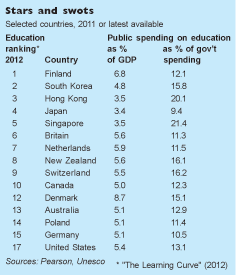Global Review: Pearson presents learning curve
Parents pore over them. teachers protest about them. Politicians preen when they are positive — and blame their predecessors if they are not. International league tables have acquired a central role in debates about education policy.
Data duels are a recent phenomenon. The OECD (a Paris-based developed-country think-tank) has published its PISA (Programme for International Student Assessment) studies of 15-year-olds’ proficiency in reading, maths and science every three years since 1997. TIMSS (Trends in International Mathematics and Science Study) has conducted four-yearly assessments of attainment at nine and 13 years of age since 1995. In 2011 it coincided with the quinquennial PIRLS (Progress in International Reading Literacy Study) which has studied nine-year-olds’ reading abilities since 2001.
Critics point out that these tests provide only snapshots: they may show what is happening, but not why. Now a newcomer is trying to dig deeper. ‘The Learning Curve’ is published by Pearson and compiled by the Economist Intelligence Unit. It uses the existing measures, but adds criteria such as graduation rates, adult literacy and the effect of years in school on productivity.
 This methodology does not change the picture at the top: Finland, South Korea and Hong Kong shine as usual, followed by Japan and Singapore. But other changes are sharp. Britain gained sixth place, whereas in the PISA 2011 report, England (without Scotland and Wales) came 25th in reading and 28th in maths. The Pearson result jolted Britons used to a diet of woeful news (the change stems mainly from the added information about post-school education). It reflects well on universities, but suggests that those who do not go on to higher education may be ill-served.
This methodology does not change the picture at the top: Finland, South Korea and Hong Kong shine as usual, followed by Japan and Singapore. But other changes are sharp. Britain gained sixth place, whereas in the PISA 2011 report, England (without Scotland and Wales) came 25th in reading and 28th in maths. The Pearson result jolted Britons used to a diet of woeful news (the change stems mainly from the added information about post-school education). It reflects well on universities, but suggests that those who do not go on to higher education may be ill-served.
Both lots of results come with caveats. Citing sampling and other flaws, statisticians had contested the validity of England’s poor PISA score. And the new study has to deal with difficulties in comparing graduation rates, and in assessing places such as Singapore and Hong Kong, where the best students study abroad. Even high performers are prone to jitters. Japanese politicians fret about competition from China, Singapore and South Korea. They are mulling a return to Saturday schooling, which ended a decade ago.
The best systems differ widely in their approach. Finland spends a modest share of its GDP on schools, pays teachers unspectacular salaries and has small classes. South Korea spends lavishly, and rewards teachers richly to teach big ones. But Andreas Schleicher, who runs the PISA studies, says both have a “high level of ambition for students and a strong sense of accountability”. That can come from an unyielding focus on exams or from tight social cohesion. Successful countries tend to hire excellent teachers and keep them motivated, monitoring their work and intervening when they falter.
A big message is that national culture matters more than the structure of an education system. So the main lesson for policymakers may be to put education at the forefront of the story a nation tells about itself. Countries which do that with conviction and consistency can leapfrog the complacent.
(Excerpted and adapted from The Economist)
Also read: Maximise children’s learning with multiple styles
















Add comment